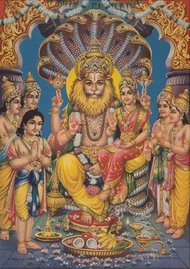The temple complex consists of an outer prakara or quadrangle which includes the shrines of Sri Hanuman, Sri Ganapathy, Sri Lakshmi and Sree Vittoba Rukmini. It also contains the Copper clad Dwaja. At the center of the inner prakara is the Garbagriha or Sreekovil which houses the deities.
On the three tiered Simhasana according to Bahu Vera Vidhana, in the Garbhagriha are installed the following deities:
- On the top most level in the centre is Lord Sri Lakshmi Narasimha, flanked by Sri Pattabhi Narasimha and Veera Vittala on either side.
- On the second tier are Lord Kodanda Rama along with Sri Lakshmana and Sita Devi, on either side of this group are Lord Hayagriva, Lord Varadaraja with his consorts and Gopalkrishna.
The idol of Lord Venkataramana is used as the Utsava moorthy. The saligrama and Naga devatas are installed on a separate Peetha below the main Simhasana. The Narasimha form is in Soumya form. Many visit this temple to pray to Lord Sri Lakshmi Narasimha for his grace for curing diseases.
A small group of GSBs migrated from
In the latter half of the 18th century and early 19th century, there was an immensely rich GSB merchant named Devdas Bhandari in Tellicherry, during the days of British East India Company. He was a trader in spices especially the famous Malabar Pepper. The legend connects origin of the SLN temple with this devout Devdas Bhandari.
One night Bhandari had a dream in which he was told that a Namboothiri (Malyalee Brahmin) would approach him with a divine Idol of Lord Lakshmi Narasimha and a sacred Saligrama, and that he has to accept the same and generously give gifts of gold and jewels to the Namboothiri in return. The same night Nambuthiri at the
In due course the Idol of Lord Lakshmi Narasimha was handed over to the Mahajans of Tellicherry by the Bandari family. A proper temple was constructed in the place occupied by the Rama shrine and the idol of Lord Lakshmi Narasimha, Lord Rama,Venkaramana with his divine consorts Sri Devi and Bhoomi Devi installed. This prathishta was done by H.H. Srimad Sumatheendra Tirtha Swamiji in 1831 A.D. on Samvatrasra Vaishaka masa Shukla Panchami, Monday, Punarvasu Nakshtra of the Shaka era. H.H.Srimad Sumatheendra Tirtha was the 15th pontiff of Sri Kashi Mutt Samsthan,
In due couse, the Bhandari family lost its glory and has to ultimately sell out his house to a non-saraswat. Even today the pooja room where the idol was kept is kept closed and protected with respect and reverence by the owner, a Navayath Muslim.
After this the
Administration of temple
The temple was for long administered by a Adhikari and two others elected by the Mahajans. In 1934, a dispute arose among the Mahajans, which ultimately resulted in the temple administration being taken over by the Hindu Religious and Charitable Endowments Board, then under Madras Govt. The land reforms bill of the 1950s took away much of the landed properties of the temple resulting in drastic drop in income of the temple. Even the poojaris could not be paid their dues. This finally resulted in the sale of temple jewellery to settle their dues. Pained with this sorry state of affairs, some community members started SLN seva samaj in 1975. The samaj collected more than 400 endowments for daily poojas.


